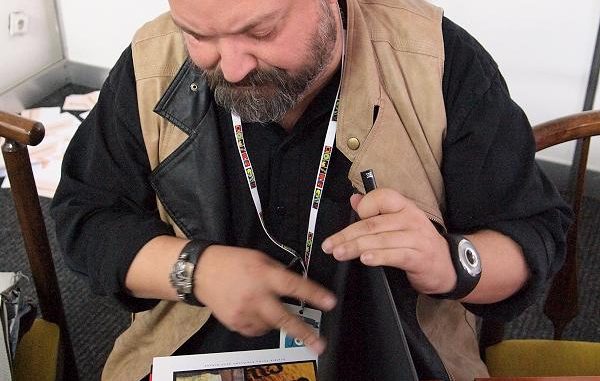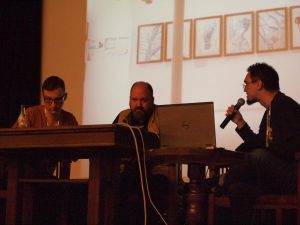
Original article appeared on Comic Conventions UK.
This is an interview that happened at the International Festival of Comics and Games in Łódź, Poland on 6th October, 2012. After Dave McKean’s panel on Saturday, I approached him and asked for an interview which took place in a friendly café not far from the main hall while drinking beer, wine and eating a cheesecake.
I went to that Polish comics festival to see mainly British comic artists like Dave McKean, John McCrea, Simon Bisley and Warren Pleece. But there were some other interesting guests from all over the world like Cameron Stewart from Canada/Germany, Tony Sandoval from Mexico and also comicbook writer, Brian Azzarello from the US.
Milán Kovács (Comic Conventions): During your panel there was a question from the audience about the fact that three quarters of stuff you had done comicbook-wise was with Neil Gaiman. What was your take on it?
Dave McKean: I’ve done a lot of stuff with Neil [Gaiman] but I tend to split my time fifty-fifty between working with other people – obviously with Neil a lot – but other people as well and then half of my own things. Books and films and sometimes comics, music and other stuff and exhibitions as well.
How do you renew your style? How do you approach new styles? Not many artists can do that and forget the style they always use so people would recognize their work.
I think it’s really boring. For me at least. It may be fine for other people but for me I would be bored stiff if I had to do the same thing all the time. I don’t mind doing one thing and really working on it and getting it right, but not forever. I simply like to learn new things. And there’s so much in the world to get inspired by…
Absolutely. And your (art)work is very diverse. On one hand you use digital techniques, photos and often manipulate them and on the other hand some of your works are ’simple’ line art. But when I see a piece of work from you it’s immediately recognizable. We can talk about styles but style is not the artist. I think it’s quite an outdated cliché.
Yes, it is. It’s just a medium, it’s not the guts of the ideas. The idea is important. The idea can be in a story or in a single image or in a concept for a whole range of things. But it’s the strength of the idea what’s important and how best and clearly to communicate it so you’re understood. I’m not interested in being vague if I have something I want to say. In fact I try to say it as clearly as I can.
And you want to say it in that style which is suited for it.
Correct.
How was working with Grant Morrison back in the day when you illustrated Arkham Asylum: A Serious House on Serious Earth?
He’s wonderful. I think he’d be an amazing writer no matter what medium he’s using. And he’s a man of great ideas but personally I wish he would not do so much superhero stuff but probably that’s just me being selfish.
He just announced he’s quitting superheroes…
He’s always quitting then restarting again. I think he has a genuine love-hate relationship. There’re some things in superhero comics that I don’t see but he sees for himself as being important and he works at those and I think he gets bored down with the companies, the publishers themselves and the editors. And you know a lot of the fans whose expectations he’s way ahead of; I think he gets bored down with that too and I think he needs to occasionally do something else. But he kind of always goes back to it.
So that’s his nature. But I think this was the only time you worked with Grant Morrison.
I did a short story with him which was completely…
Sorry but where was it published?
It was published in Piranha Press Magazine called Fast Forward and actually I’m going to try and reprint it. I’m gonna try to do a third Pictures That Tick book of short stories but they’ll all be collaborations so I’ve done a story with Grant [Morrison], another one with Neil [Gaiman] and I’ve done one with guitarist Buckethead. He wrote the story and I adapted it.
That’s very interesting. I mean it’s always special when writers from other genres come to the comics medium and they usually find new ideas and bring some fresh air too.
Was it difficult to make it interesting visually? I mean in Arkham Asylum roughly the whole plot happens in the same place.
Actually I really liked that. I like it when you got a defined place even though it was a labyrinthine kind of woolly space. I like it when you got something that sort of hangs around and then it becomes more of a psychological space. So to make it different you have to not just draw what it looks like but what the feelings in the room are.
It’s kind of an expressionist approach on your side.
Expressionist, exactly.
What do you think of people saying that Arkham Asylum is a complicated and therefore uncomprehendable work?
That’s fine. The two different reactions are ’I’m not sure I understand this but I want to think about it further, read it again and see what the references are and look them up and spend some time on it’ or ’I don’t really understand this and therefore it doesn’t make any sense.’ So I understand both reactions but honestly I have more sympathy with the first one.
Honestly Grant Morrison’s other works are like this too so some people hate them and others like them but they don’t necessarily understand them.
But you have to think. He demands the attention to details. People who don’t want to pay attention have to read someone else’s stories.
Actually I’m in love with these references in his stories and Arkham Asylum like you drew it was also like a big symbolism psychologically. And it was also an expressionist and experimental graphic novel. The characters weren’t the same from page to page and that’s OK for me but I can understand not everyone likes comics this way.
Absolutely, I suppose you also have to question your own expectations. If someone wants to read a classic Batman story there are thousands out there. We were trying to do one book that was a bit different.
But I think it came out in the right time I mean the same year the first Batman movie came out. That was a lucky shot.
Yes, you know the best plan is to be lucky.
How would you describe your style as a comic artist – I think it’s impossible – and as a fine artist? Who were your influences?
There’re so many it’s very hard to pin them down. There have been people whose work meant a lot to me at a particular moment and there are a very few who stayed with me for the whole time. So I mean the comics I liked when I was very very young are not really the comics I like now. You grow and change. A guy who was doing comics in the 2-3 years before me and using illustration techniques and everything was obviously Bill Sienkiewicz in America. And I liked them very much when I saw them but they don’t mean as much to me now. When I first saw Lorenzo Mattotti’s comics they meant a huge amount to me then but they really stayed with me and I think he’s the best in the world.
And in fine art most of the greats I love. They’re greats because they’re great.
But do you have some contemporary artists you like?
I do, I really like Rachel Whiteread who makes installations.
So you like installations?
No. I do like all of everything. Some of them are rubbish but some are good. You can’t just say it’s all great or it’s all bad.

But like your recent exhibiton called The Blue Tree in the Rye Art Gallery was more of an installation than a simple exhibition.
They were very much together. They paid off each other. And the interesting was the fact that the installation went out into the town and grew out into the town as prior to the exhibition opening we went out at night and put these small blue branches on the trees.
Artists do things like that in Hungary too but as far as I know it’s illegal.
Well we were strictly illegal but they were very forgiving. But the thing about a lot of that stuff it may be fun and it may be out in the streets but that’s a good thing. But very often it’s pretty hard to discern really what it’s about. So that’s why I still love the simple act of telling a story. And the story exists in a room and in the room there’s an installation that goes out to the street and it all starts to talk to each other. But you can read the story and the story is great for opening the door into your thoughts. You know often galleries are very forbidding and you don’t know how you supposed to react. And maybe you feel a bit stupid because you don’t get it, all of those feelings which I understand correctly. The stories are great for breaking that down and inviting you in.
When I was in London at the Damien Hirst exhibition sometimes people stared at paintings section watching the colourful points and circles and they said ’oh that’s fantastic’. What do they make of them?
I’m not sure why they do that.
I like Hirst’s works. Some of his works. But not all of them.
Again, some. You’re allowed to do that.
You have a huge collection of cover work for Sandman. How did you approach each new cover so don’t make them too much alike?
Well, looking back at the covers because it was quite a long time…
Actually I didn’t even read comics when you started…
That’s pretty terrifying. So it took up quite a chunk of my life. Looking at them now they’re like a diary. A monthly diary where I got to do a cover a month and that month, at that moment looking at them now I remember exactly the music I was listening to and what I was feeling, the art I discover at that time as well. Because when you make something, you draw something or create something you really pay attention and you’re very focused and so seeing it again brings back exactly how I was feeling, where I was doing it and stuff I was listening to. It’s really sharp.
But it’s maybe because you’re a visual man, you have a visual memory.
I think it is to do with how much your senses are waving. You know your entire act when you’re creating something. I noticed it with my children I did these little travelbooks, sketchbooks…
Yes they’re very nice but I don’t see where I can buy them. I didn’t even know they existed.
I know. I’m trying to find individual shops in different cities to take them.
Because this is the one the tourists have to buy. Not those maps with photos and those street photo books of famous buildings and sculptures.
I agree completely, absolutely. I started in Vienna I had a sketchbook and my kids had a sketchbook and we got to the end of the holiday and usually my kids used to remember the minibar in the hotel and the airport, they never remembered anything that we saw. But because they’ve drawn it all – we went to galleries and we drew everything we saw like statues and paintings, they remembered everything, even the names of the artists. It’s wonderful.
It’s very interesting and it helps them to broaden their memories.
Yes, it just makes you more sensitive.
What did you want to be when you were just a child? Were drawing and illustration always present in your life?
Yes, absolutely yes. I always remember drawing and then I play the piano as well so music and art were my two big loves. I never really wanted to be anything else. I never wanted to be a fireman or…
This is the best I think if you don’t do this because your parents wanted you to be an artist.
In fact quite the opposite I think my parents… because they didn’t know any artists so they didn’t know anybody who made a living doing anything creative they were worried that I would not make a living so they tried to suggest things that were a bit more sensible.
What do you do in your spare time – if you have any? That’s also part of the question.
Much better. I like drawing so I do it most of the time because I would do it if it was my job or not. I just like doing it. Anyway I play badminton and I play music. And that’s about it but of course I have a family and wife so family life as well.
Do you read comics? If so what comics are you interested in?
I do. I don’t really read series anymore. I read the volumes and mostly graphic novels and I tend to read a single graphic novel and they tend to be the ones published by one of the modern book publishers who’re pulling together wonderful graphic novel lines. I haven’t read a series for a long time.
What did you read recently?
Well, Lorenzo Mattotti’s Stigmata came out in English and also another book that just came out from Fantagraphics called The Crackle of the Frost. A book by Frederic Peeters called Blue Pills and also Shaun Tan’s The Arrival.
I also want to read other stuff I don’t know about. I started with superhero comics like most people but nowadays I’m more into more serious and creator owned stuff.
Yeah, there’s just a world of other things like that. I really love Shaun Tan’s books, The Arrival, it’s a beautiful book. Do you know his books?
Not really but I will surely check out with your other suggestions too.
Thank you very much for the interview and it was a pleasure to meet you, Dave. Hope to meet you again soon!
Thank you and my pleasure too.
